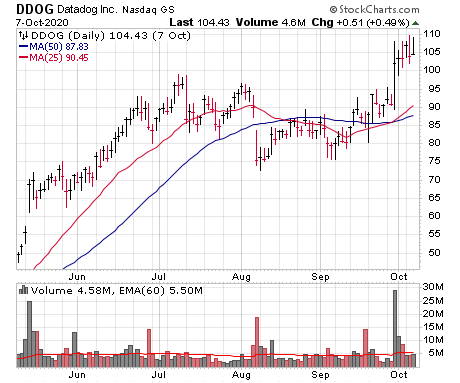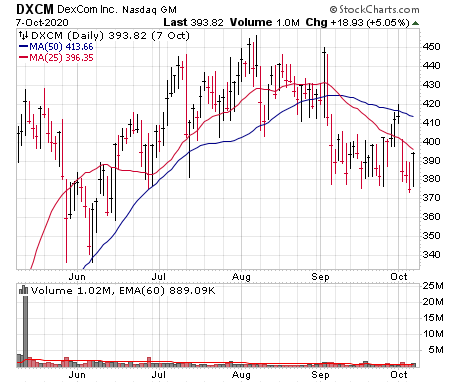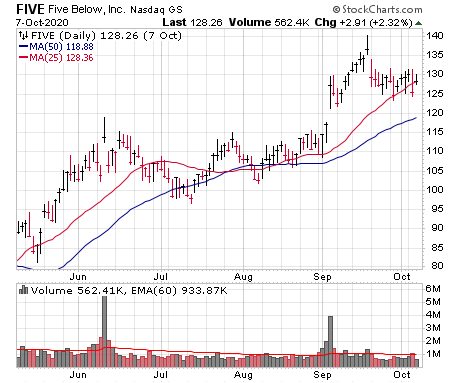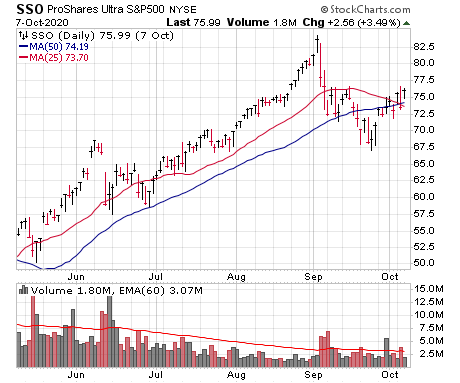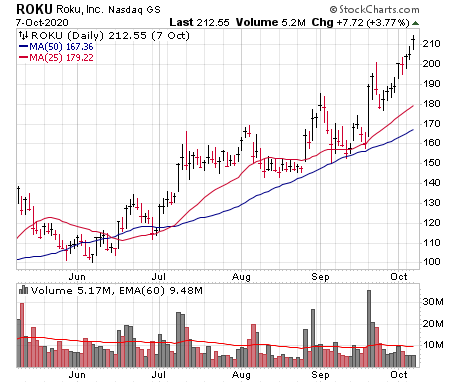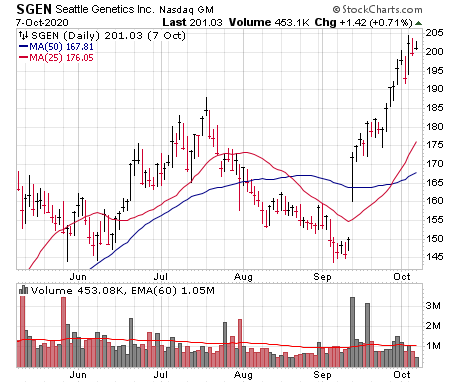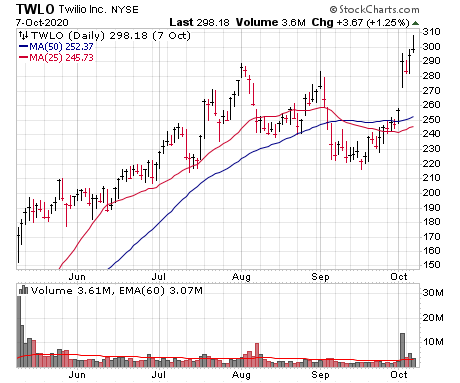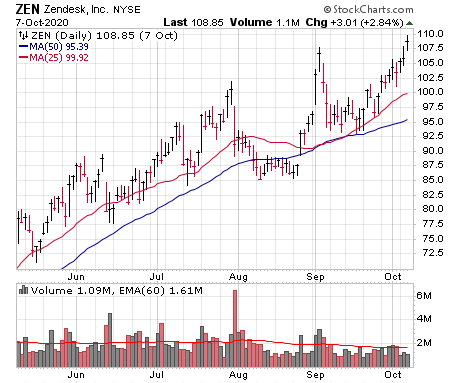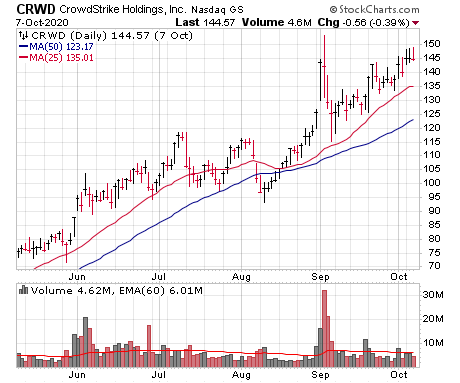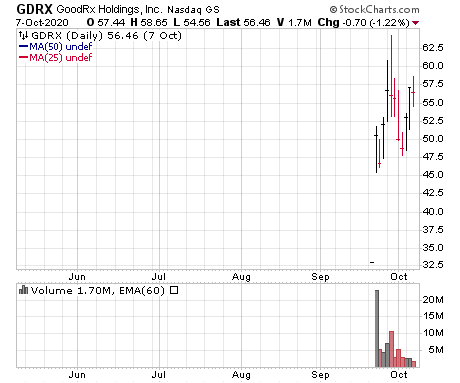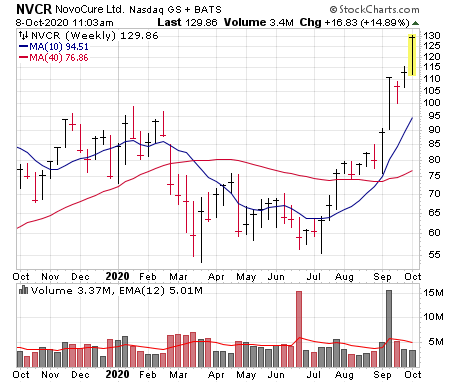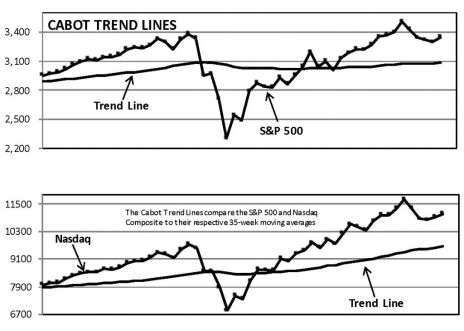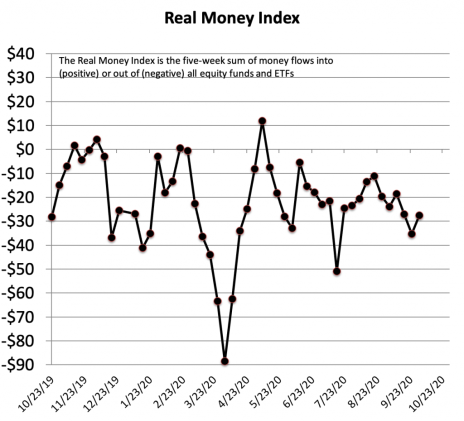It’s not a blastoff-type of environment, but the evidence has steadily improved during the past three weeks, first due to the action of leading growth stocks, and now, our Cabot Tides have returned to bullish territory. Thus, we continue to follow the evidence, slowly putting money to work and rotating into stronger situations. Last week, we averaged up in two of our recent buys, and tonight, we’re adding a full position in a fresh leader.
Elsewhere in tonight’s issue, we write about the ups and downs of recent IPOs, as well as one sector that is beginning to reemerge and has many stocks that fit our stock picking criteria.
Cabot Growth Investor 1456
[premium_html_toc post_id="217397"]
Steady Improvement
By the letter of the law, the big-cap indexes remain in the midst of a correction—the S&P 500 sits about 4% off its high, while the Nasdaq is more than 5% below its early-September peak, and many stocks and sectors are being tossed around by news on a daily basis, whether it’s “real” (earnings, share offerings, etc.) or stemming from macro factors (such as the upcoming election).
But for most of 2020, we’ve been placing more emphasis on bottoms-up analysis (the action of leading stocks) rather than top-down analysis (the action of the major indexes). Both are obviously important, but so many stocks and sectors have been dancing to their own drummer this year that we’ve been able to be a bit ahead of the curve (and well ahead of the market in terms of performance so far this year) by focusing on the leaders first.
Focusing on the leaders was the big reason we raised cash in August, as those names sagged despite strength in the indexes. And it’s the main reason we began putting money back to work in mid-September, even as the market was acting iffy. And, encouragingly, the action among these stocks has shown steady improvement since then, which we see in our own P&L, as well as in broader measures, too. Yesterday, for instance, the number of stocks on the Nasdaq hitting new highs reached 152, the largest figure since the Nasdaq’s summit six weeks ago.
Moreover, even the indexes have improved, led, surprisingly, by the small- and mid-caps, the latter of which also hit a new high this week. After a brief trip to the bearish side of the fence, the recent strength has helped our Cabot Tides return to positive territory, which is always encouraging.
Those are all positive tidings, but to be fair, we don’t view this as some sort of blastoff scenario like we saw in April. We’d be happy to be wrong, of course, but while some names have raced higher, we’re still seeing plenty of news-driven market moves, rotation and a decent amount of selling on strength.
None of that is bearish, but it does raise the odds that the market is still in something of a set-up phase (rather than a “Go” phase); many big investors could need more time to reposition their portfolios, and of course the well-known uncertainties (read: election) could easily cause a couple of potholes.
What To Do Now
Put it all together, and we’re increasingly optimistic, but we’re putting money to work on a step-by-step basis as opportunities arise. Last week, we filled out our positions in Pinterest (PINS) and Seattle Genetics (SGEN), both of which are acting well. And in tonight’s issue, we’re adding a full position in Datadog (DDOG), which has the makings of a winner. Our cash position will now be around 23%.
Model Portfolio Update
The market’s picture has brightened during the past couple of weeks, though —there’s definitely been improved action among the major indexes and many leading growth stocks (which, as we wrote on page 1, we’re placing some more emphasis on these days), though the big-cap indexes still have resistance to chew through and the environment remains very news-driven.
Thus, we’ve been extending our line while rotating into some stronger situations, but we’re not flooring the accelerator given the headwinds that still exist. Last week, we filled out our positions in Pinterest and Seattle Genetics, and tonight we’re going to add a full position in Datadog (DDOG).
That will still leave us with around 23% in cash, and we’ll just take it as it comes going ahead—we’re certainly not opposed to becoming heavily invested, but we still have a couple of laggards (especially Wingstop) on tight leashes and aren’t ruling out more shenanigans from the market in the weeks ahead.
Current Recommendations
| Stock | No. of Shares | Portfolio Weightings | Price Bought | Date Bought | Price on 10/08/20 | Profit | Rating |
| Datadog (DDOG) | New | — | — | — | 103 | — | Buy |
| Dexcom (DXCM) | 290 | 6% | 216 | 11/15/19 | 415 | 92% | Hold |
| Five Below (FIVE) | 1277 | 9% | 138 | 9/18/20 | 132 | -4% | Buy |
| Pinterest (PINS) | 4444 | 11% | 40 | 9/18/20 | 44 | 9% | Buy |
| ProShares Ultra S&P 500 (SSO) | 1,741 | 7% | 60 | 5/29/20 | 77 | 29% | Buy |
| Roku (ROKU) | 548 | 6% | 170 | 8/28/20 | 224 | 32% | Buy a Half |
| Seattle Genetics (SGEN) | 954 | 10% | 186 | 9/18/20 | 199 | 7% | Buy |
| Twilio (TWLO) | 553 | 9% | 174 | 5/8/20 | 299 | 72% | Buy |
| Wingstop (WING) | 1,313 | 10% | 128 | 6/19/20 | 130 | 2% | Hold |
| CASH | $599,505 | 33% | . |
Datadog (DDOG)—Back in the late 1990s, EMC was a huge winner as it was the leading provider of a key product (storage systems) that were necessary due to the budding internet boom. Datadog reminds us a bit of that situation—its application performance management and infrastructure monitoring platform is perfectly suited for the cloud age, as all the companies who are creating and implementing dozens of new apps need to make sure they are optimized, work well in concert and can be troubleshot if necessary. Growth has been fantastic (revenues up 68% even with all the Q2 headwinds; earnings are taking off), and the sub-metrics here are really impressive (same-customer growth rate over 30% for 12 straight quarters as usage soars; overall retention rate is in the low 90% range even as some smaller customers go bust in the recession). And the story is getting better, as Datadog’s offerings are now integrated into Microsoft’s Azure cloud platform, which should boost adoption. The stock was one of the leaders this spring, corrected and consolidated for a couple of months and then broke out on its heaviest daily volume ever (second biggest weekly volume) on the Microsoft news. We’re taking a “full” (10% of the portfolio) position here, with a mental stop in the upper 80s. BUY.
Dexcom (DXCM)—Before DXCM really got going late last year, competitive rumors and reports used to always jerk the stock around. That wasn’t the case in recent months, but last week saw some of that return—one analyst opined that Abbott’s continuous glucose monitor (Libre) will put pressure on Dexcom’s G6, which is priced much higher, and that briefly drove the stock to multi-week lows before bouncing. It’s not the best sign, but such news-driven moves are the norm in this environment, and if investors had really moved on, you’d expect to see DXCM give up the ghost (which it hasn’t). Overall, we’re still holding, but our patience is running thin—our mental stop is now in the 360 area (give or take), and we’ll simply let the stock tell us what to do going forward. Earnings are due out October 27. HOLD.
Five Below (FIVE)—FIVE is still lower than our entry point from three weeks ago, but frankly, we think it looks fine—volume has been tame on the recent pullback after its earnings-induced breakout and rally in September. To be fair, this stock is probably our most sensitive to macro news, both with the election (which could affect the China tariff policy) and the virus (shut-ins, voluntary or forced, wouldn’t help business), so some hesitation here isn’t totally surprising. But the core fundamental story is as good as ever and the stock acts normally here and, frankly, looks to be at a good entry point. A drop under 120 may change our minds, but right now, you should hang on if you own it, and if you don’t, you can pick up some shares now. BUY.
Pinterest (PINS)—Mass market? Check. One-of-a-kind offering? Check. Rapid sales and earnings growth projections and an early-stage chart? Check. There are never any sure things, but Pinterest has just about all of the characteristics of prior big winners, so if management pulls the right levers, we think the stock has a chance to do very well over time. Really, the big idea is that the company is a leader in a new kind of online shopping (social commerce), which attracts people who are at a different stage of the buying process (looking for ideas of what to buy, as opposed to shopping for a specific product)—and that will in turn attract advertisers that are looking to get in front of potential customers earlier in the process. There’s plenty of upside in the monetization of the firm’s user base (especially internationally), and analysts see 30%-plus revenue growth (plus booming earnings) for many quarters to come. A pullback of a couple of points wouldn’t shock us, but the path of least resistance is clearly up. We filled out our position last week. BUY.
ProShares Ultra S&P 500 Fund (SSO)—Our Cabot Tides have returned to bullish territory, though in a role reversal, it’s the broader indexes (NYSE Composite plus the small- and mid-caps) that are leading the way higher. Even so, the S&P 500 (and, by extension, SSO) isn’t doing badly, having recouped about 60% of its correction to this point. As we wrote earlier, we’re not ruling out some more shenanigans from the market, especially as the election approaches and everyone places their bets one way or the other. But you know us: We like to go with the evidence in front of us, and with the market’s long-term trend being solidly up (never any doubt of this in recent weeks) and the intermediate-term trend beginning to poke higher, we’ll restore our Buy rating on SSO, thinking the next major move is to the upside. Just don’t be shocked to see some ups and downs in the near future. BUY.
Roku (ROKU)—A week ago, we held off adding more shares to ROKU because the stock was up against round number resistance (near 200) and the latest rally had come on light volume. Since then shares have … continued to rally straight up on light volume (at least until today), tagging new highs almost daily! We’re not complaining, of course, but we’re also not in the mood to chase the stock higher at this point given the recent run and still-tricky environment. Big picture, we remain very bullish because of the company’s central position in the connected TV market and because of the repeated big-volume buying in the chart—look at all the big black (up) volume bars on the daily chart in recent months, which is almost always a sign that big investors are building positions. If ROKU can calm down for a bit (or shake out sharply for a couple of days) we could fill out our position, but right here we’ll stick with what we have. We do think it’s fine to pick up a half-sized position if you don’t own any, preferably on dips. BUY A HALF.
Seattle Genetics (SGEN)—SGEN certainly acts like the weak hands were worn out during the prior two-month decline, as the stock has basically moved straight up to new highs since the Merck collaboration (and equity buy-in) announcement in mid-September. Of course, buyouts are always possible in the biotech space, but this is far more than an acquisition play—Seattle’s combination of Adcertis, Padcev and Tukysa are expected to drive huge sales and earnings growth in the years to come, and the pipeline got a big boost from that Merck deal, as the two companies will jointly develop one of Seattle’s drugs (dubbed ladiratuzumab vedotin) as a treatment for a variety of tumors (partly in conjunction with one of Merck’s treatments). And Merck clearly thinks there’s big potential here: In addition to the $1 billion equity stake Merck took in SGEN, Seattle also got a $600 million upfront payment and is eligible for another $2.6 billion of milestone payments if things go as hoped! Yes, it’s good for business and the bottom line, but just as important, we think this event serves as a perception-changer for institutional investors, as SGEN has morphed from a solid-looking biotech into one that has all the makings of a future blue chip. We filled out our position last week (adding another 5% stake) and are giving our shares some room to maneuver. BUY.
Twilio (TWLO)—It’s never enjoyable to sit through a 25% correction like TWLO went through, but given all of the fundamental (its communications platform is even more central now that everything is moving online and going mobile) and technical (lifted from a re-set base in May on unusual power) evidence, the odds strongly favored another leg up. And that leg has likely gotten underway, thanks mainly to a bullish Investor Day last week that highlighted the firm’s extremely bullish long-term outlook. The financial highlights were that the top brass sees Q3 revenue topping expectations, but more important, it went on record saying it thinks it can crank out 30% annual top-line organic growth (i.e., not including any acquisitions) for the next four years. Beyond that, though, there were a bunch of enticing tidbits: Twilio’s revenue churn rate remains just 2% or so, meaning very few customers are leaving; its Flex offering (cloud-based call center) is growing like mad, with revenues up 184% in the first half of the year; more than half of revenues now come from non-messaging functions (though messaging itself is showing accelerating growth, up 59% year-over-year); and management sees its addressable market growing 40% between now and 2023. Long story short, Twilio is going to get a lot bigger over time, especially as the pandemic has accelerated the need for its services. That doesn’t mean it’ll be straight up from here—300 could be round-number resistance, and the Q3 report on October 27 could push the stock around. But the huge volume clue last Friday (five times average volume) that pushed TWLO to new price and relative performance (RP) highs is what we’re focusing on. We’ll go back to Buy. BUY.
Wingstop (WING)—It’s not the news that counts, but a stock’s reaction to the news, and with that in mind, WING is on the edge of being thrown overboard. This week, the firm released preliminary Q3 results that looked terrific: Domestic same-store sales rose a whopping 25%, while system-wide sales were up 33% and the company was able to open 43 new locations in the quarter. However, after a brief pop, the stock sold off on good-sized volume on the news, and shares are currently back near the lows of their consolidation (and just above our cost basis). Is it possible this is the final shakeout of a two-month correction? Yes, especially given that business is good and getting better. But it’s also possible that the so-so expected growth (earnings up just 13% next year) could put a lid on the stock for a while. We’re happy to continue following our plan (mental stop around our cost of 128), but that means WING will have to shape up right around here. Hold for now. HOLD.
Watch List
- Beyond Meat (BYND 193): BYND continues to act very well and we think this consumer-related story has legs. Our only rub is the stock’s insane day-to-day volatility, which makes it hard to hang on to.
- CrowdStrike (CRWD 143): CRWD has a broad-based cybersecurity platform that’s cranking out rapid growth, and the stock has shown unusual resilience during the market’s recent correction. See more later in this issue.
- DraftKings (DKNG 51) and Penn National Gaming (PENN 66): DKNG has looked a little abnormal after a share offering, but a dip from PENN close to its 10-week line (lower 60s?) could be buyable.
- Novocure (NVCR 129): Novocure has a great story, excellent numbers and huge potential if it gets approval to use its Optune system on more and more cancers. See more later in this issue.
- Square (SQ 184): SQ popped to new highs earlier this week well ahead of the market, a solid sign of leadership. The new legs to the growth story (Cash App, Cash Card) are enticing, as are the buoyant earnings estimates.
Other Stocks of Interest
The stocks below may not be followed on a regular basis. They’re intended to present you with ideas for additional investment beyond the Model Portfolio. For our current ratings on these stocks, see Updates on Other Stocks of Interest or email mike@cabotwealth.com.
Zendesk (ZEN 108)—Zendesk has long been a good growth outfit, though its stock has been trickier to handle—but it appears that, after a long up-and-down period, it’s ready to get going if the market cooperates. The company has positioned itself as the leading new-age provider of customer relationship solutions, helping firms (especially mid-size to bigger ones) improve engagement, better understand what customers are looking for and better adjust as clients’ needs do. And it’s expanding quickly, adding services (talk, chat, messaging, selling, etc.) to its core support functions that are being gobbled up. The firm’s latest innovation, dubbed Sunshine, could be big; it’s a flexible CRM offering that allows firms a single place to store all customer-related data and (more importantly) mold it, with developers and administrators able to build custom tools and apps to improve service. Growth has slowed a touch as Zendesk has gotten larger ($925 million in annual revenue), but even with the disruptions in Q2, sales were up 27%, earnings nearly tripled and total future revenue under contract (dubbed remaining performance obligations) was up a solid 35% from a year ago. The stock had a good (but choppy) run into the middle of last year before suffering two huge dips over the next nine months. ZEN did rally back with everything else after March, and after hacking around for the past couple of months, appears to have shaken out the weak hands—shares steadied after some early-September weakness and are now testing new-high ground.
CrowdStrike (CRWD 143)—We’ve latched onto Okta a couple of times in recent years and made solid money each time. But if we return to the new-age cybersecurity sector in the weeks ahead, we’ll likely go with CrowdStrike, which has a stronger chart (right now anyway), faster growth and, while the story is a bit of an ice cream headache, the big idea here is simple: CrowdStrike’s cloud-based endpoint security platform (an endpoint is anything that touches the network, including every phone, tablet, computer and IoT device out there!) is positioned to be the next must-have platform among enterprises (joining the likes of Salesforce, Workday, ServiceNow and others) as the world rapidly transitions away from old school, on-premise security boxes. One of the secret sauces that differentiates CrowdStrike is that it crowdsources data; the firm’s proprietary, AI- and machine learning-powered system inputs three trillion events per week (!), making it better able to identify preemptive indicators of attack and then distribute the defense (thanks the cloud) to all clients quickly. The pandemic is only helping the company’s cause (it stopped 41,000 potential breaches in the first half of the year, more than all of 2019), and the firm is moving into adjacent fields, too. Growth has been spectacular (revenues up 80%-plus many quarters in a row) and profits are ramping up as CrowdStrike seems to be the platform of choice among big firms (49 of the Fortune 100 are customers). The stock has been strong since the March lows, but what’s really caught our eyes is the recent action is that CRWD hasn’t even touched its 25-day moving average in recent weeks, even when growth stocks were getting hit. We like it.
GoodRx (GDRX 55)—We don’t jump on super-new IPOs (see more on that later in this issue), but GoodRx is certainly a name to keep an eye on as it has many traits of prior big winners. The company has a platform that, thanks in part to partnerships across the healthcare system (a big barrier to competition), allows it to run 150 billion pricing data points every day, thus allowing users to often find better deals in their area on prescriptions simply by having the pharmacy scan their GoodRx code on their phone. That not only saves consumers money but cuts down on the 20% to 30% of prescriptions that are ordered by a doctor but are never picked up by the patient, usually because of cost; more compliance means better outcomes, which lowers healthcare costs overall. GoodRx gets a cut of the initial and any subsequent refills of that prescription, often leading to a stream of recurring revenue. (Since 2016, over 80% of the firm’s transactions are repeat orders.) It also offers subscription plans that guarantee very low costs for many prescriptions, and/or offer deals through specific pharmacies (like Kroger). It’s even gotten into the telehealth market, with a marketplace where users can get a quick, virtual consult and often have a prescription filled. Right now, though, prescriptions are the big driver, and given the size of the market (5.8 billion 30-day equivalent prescriptions are dispensed in the U.S. each year!), GoodRx has massive potential, and it’s been taking advantage of it: Revenues were cranking ahead in the 60%-plus range before the virus (up “only” 35% growth in Q2) and earnings have been solidly in the black for many quarters. With around $470 million in revenues during the past four quarters, we see no reason the company can’t grow many-fold from here. The stock is just a few days old but is handling itself well; let’s see if it can form a tight zone for two or three weeks, which can often provide a decent entry point for new issues.
IPOs: New Leadership, but Handle with Care
We always keep our eyes on recent IPOs, as many of these new issues can eventually provide new leadership to the market. However, there are three key things to remember when dealing with recent new issues. (All data to follow comes right from The Lifecycle Trade, a great book written by Eve Boboch, Kathy Donnelly and others.)
First, buying on the initial IPO is risky. Since 1982, 55% of IPOs undercut their first day close within three weeks, while half fall at least 10% from their initial close within nine weeks. Second, after an initial consolidation phase, some IPOs can make big moves, but it’s somewhat rare—less than 12% double from their initial close within six months.
Third and most important, even if the stocks do have a big run, that run tends to be relatively short-lived; of those huge winners, nearly three-quarters went on to fall 50% or more sometime in the following year!
Said another way, recent IPOs can sometimes be good for an initial, multi-week pop, but you have to treat them like trades, not investments; the vast, vast majority will peter out and enter what we like to call the post-IPO droop. Ironically, that droop, which can last many months or even years, tends to set up what ends up being a great longer-term buying opportunity.
Twilio (TWLO) provides a good example. The stock came public in June 2016 and
enjoyed a great run as the market was in a bullish mood at the time; after etching a brief launching pad in July, the stock zoomed from 45 to a high of 71 in September. But then came the droop, and by early November, it was down to 30! And that was just the beginning—as you can see here, in February 2019, the stock was sitting near 25 ... where it finally blasted off from to begin a sustained, 15-month advance.
Because of the short-term, hit-or-miss profile of recent IPOs (along with some other factors, like questionable liquidity and sponsorship), we rarely go there in the Model Portfolio, where we take bigger positions and try to play out a big-picture move. Of course, there are exceptions to every rule (GoodRx (GDRX), written about earlier in this issue, has a great story and numbers), but the point is if you do delve into a very new issue, just realize that a sustained, steady advance is unlikely, so be ready to pull the ripcord if the stock begins to falter.
Medical and Biotech Firming Up
Our m.o. when evaluating fundamentals is to look for firms with growth stories that have the “three Rs”—rapid and reliable growth, with a long runway of growth ahead—because such a combination attracts hundreds of funds who feel comfortable building positions over time, knowing the growth story is very likely to play out.
There are a couple of sectors that lend themselves to such a profile, one of which is medical—nearly every breakthrough drug, device or service is patented, so once a new solution hits the market (and once insurance companies are OK paying for it), sales and earnings usually glide higher for many years, especially if the products serve a mass market (i.e., diabetes) or the firm has a few irons in the fire. In fact, three of our recent winners (Dexcom, Teladoc, Vertex) were medical stocks.
Today, our favorite in the group is Seattle Genetics (SGEN), which we own in the Model Portfolio; the company’s best-in-class Adcertis treatment should have years of slow expansion ahead of it, while Padcev and Tukysa drive meaningful sales and earnings growth in the years ahead.
But we’re seeing other medical stocks perk up, too. On our watch list is Novocure (NVCR), a name we followed last year before
it went over the falls when the market crashed. The company has what could be a new way to treat many cancers—its Optune system uses low doses of radiation (called tumor treating fields) to disrupt cancer cell growth (and cause cancer cell death, too). Growth has been and should remain solid thanks to approvals for a couple of cancers, but the real payoff could start in 2021 and beyond as Optune is in Phase III trials for three more huge applications (non-small cell lung, pancreatic and ovarian cancer) that, if approved, would increase their target market fivefold. NVCR has decisively broken out on the upside and the next pullback should offer up a solid entry point. WATCH.
Cabot Market Timing Indicators
The evidence isn’t perfect, but it continues to improve—our Cabot Tides have flipped back to bullish and, even before that, individual growth stocks began showing some upside power. We’re not pedal-to-the-metal bullish, but we have been slowly extending our line and moving into stronger situations.
Cabot Trend Lines: Bullish
Our Cabot Trend Lines remain bullish, with both the S&P 500 (by 8.6%) and Nasdaq (by a big 14.6%) not coming close to threatening their respective 35-week moving averages. Contrarily, maybe that means the market needs to consolidate for a few more weeks to get more investors to bail out, but either way, there’s no doubt the long-term trend is still up—and that means the overall bull move is alive and well.
Cabot Tides: Bullish
Our Cabot Tides have returned to sunny territory after a brief spell on the bear side of the fence—all five indexes (including the Nasdaq Composite, daily chart shown here) are above their lower moving averages, and interestingly, most of the strength is in the broader indexes (a change from most of this year). Of course, it’s always possible we chop around further in the near-term, but just going with what’s in front of us, the intermediate-term trend has rejoined the longer-term trend on the upside.
Cabot Real Money Index: Neutral
The Real Money Index was on the verge of turning positive, thanks in part to a huge outflow ($14.9 billion) during the market’s late September retreat. But overall, the five-week sum of outflows has steadied, so we remain in neutral territory—we’ll be looking to see if recent events and headlines have people moving into or out of the market in a big way, which could prove to be a good contrary signal.
Charts courtesy of StockCharts.com
The next Cabot Growth Investor issue will be published on October 22, 2020.
Cabot Wealth Network
Publishing independent investment advice since 1970.
CEO & Chief Investment Strategist: Timothy Lutts
President & Publisher: Ed Coburn
176 North Street, PO Box 2049, Salem, MA 01970 USA
800-326-8826 | support@cabotwealth.com | CabotWealth.com
Copyright © 2020. All rights reserved. Copying or electronic transmission of this information is a violation of copyright law. For the protection of our subscribers, copyright violations will result in immediate termination of all subscriptions without refund. No Conflicts: Cabot Wealth Network exists to serve you, our readers. We derive 100% of our revenue, or close to it, from selling subscriptions to its publications. Neither Cabot Wealth Network nor our employees are compensated in any way by the companies whose stocks we recommend or providers of associated financial services. Disclaimer: Sources of information are believed to be reliable but they are not guaranteed to be complete or error-free. Recommendations, opinions or suggestions are given with the understanding that subscribers acting on information assume all risks involved. Buy/Sell Recommendations: All recommendations are made in regular issues or email alerts or updates and posted on the private subscriber web page. Performance: The performance of this portfolio is determined using the midpoint of the high and low on the day following the recommendation. Cabot’s policy is to sell any stock that shows a loss of 20% in a bull market or 15% in a bear market from the original purchase price, calculated using the current closing price. Subscribers should apply loss limits based on their own personal purchase prices.

